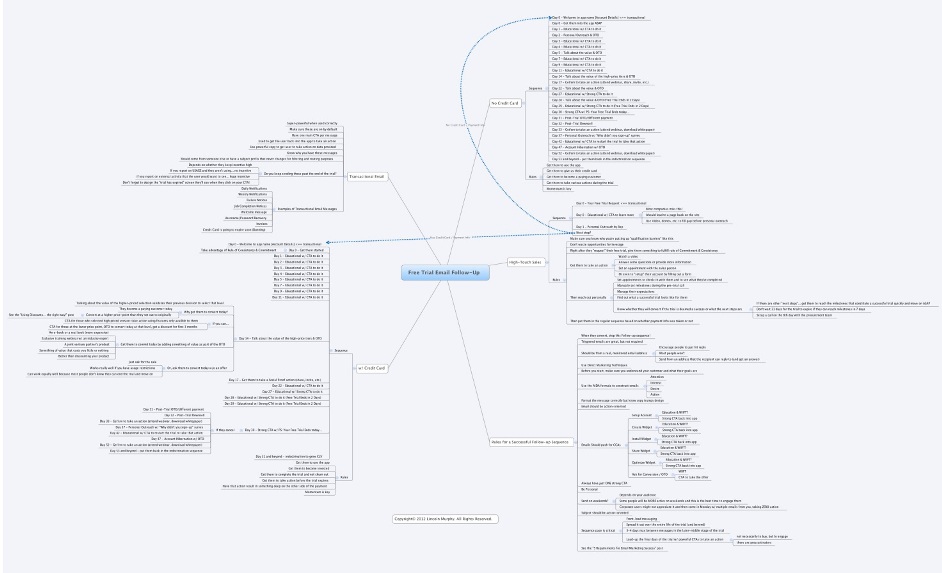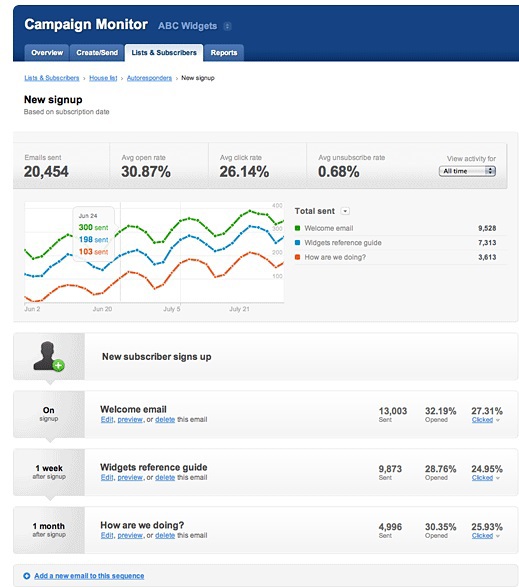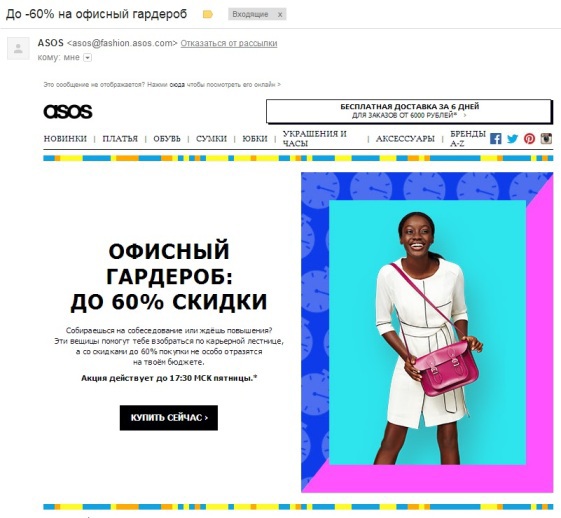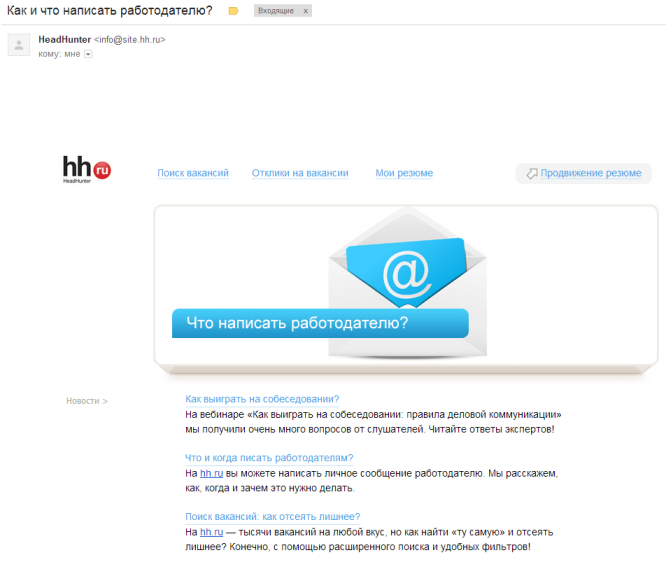Template mailing is dead: how to create the perfect sequence of e-mails for mailing

This time we would like to share a Lincoln Murphy article written in the first person. It can be useful to many Internet business owners: it can be used to find out why the trigger mailing is usually more effective than the template one, and what types of e-mails can be used in the sequence of e-mails. We supplemented the article with examples of the most successful mailings.
The evolution of mailing: from the template to the trigger
Whatever the monetization model - free trial period, freemium, demo version or paid tariffs, the founders of the services constantly ask how to organize the most effective mailing and choose the correct sequence of automatic emails.
')
For most Internet business leaders, finding the perfect sequence of automatic email reciprocal seems useless hard work, low-level work. In contrast, high-level work is when the correct settings go down from the corporate top. Only company leaders can develop proper customer service practices for employees who are responsible for mailing.
Installation for successful work with clients and properly organized activities are the key points of modern online business.
Senior executives must fully understand and think through the business model in detail, and then incorporate this understanding into the organization. It is also important to realize the need to use the full potential of the chosen model.
Quite often, the choice of tactics comes from the strategic decisions of the authorities, and if the organization is not focused on successful work with clients and does not try to think through a business model, then ultimately strategic mistakes will appear in its tactical decisions.
Not later than February 2012, I shared with the group of top managers my associative map in PDF format, which, I thought, was the perfect sequence of emails in the automatic mailing list.

Source can be found here.
At that time, the best way of distributing and arranging automatic e-mails was to send them at the initial time interval.
But ... in the end, I saw that the model does not work so well.
When I shared it with members of the project team that I lead, I already started working with trigger mailings, which are based on activity within the application, they are also called event mailings, as opposed to traditional ones - temporary ones.
But, despite the fact that trigger mailings based on user behavior began to gain momentum in 2013, they still have not become ubiquitous.
Almost 2 years ago, this type of mailing scheduling was hardly ever used by Internet business owners.
At that time, people needed template mailings, despite the fact that the effective work of the “answering machine” - a sequence of letters with a specified time interval - still depended on the things that most users do on your service during the free trial period. In turn, this set of actions depends on the buyer, product, its complexity, price, positioning, and so on.
But it's time to put the cards on the table.
Automatic e-mailing systems with a specified frequency outlived themselves
In 2014, the use of "advanced" automatic sending of emails without orientation to user behavior is already the last century.
In fact, if you still send e-mails that are not based on anything other than a certain frequency and time of sending, instead of linking them to user activity, then you are already 100% doing everything wrong.
If you speak softly, then of course, using automatic mailing with a given frequency will still be much better than not doing absolutely nothing (which, unfortunately, many entrepreneurs do). But it is worth knowing that such a mailing is, firstly, far from ideal, and secondly, you can do better.
In 2014, it is simply unacceptable not to take into account when forming a system of responses to letters, the actions of future buyers and customers, and to interact with all of them in one pattern.
As Nick Mehta, CEO of Gainsight , told me earlier, the voice of the buyer is in his actions. Sure, it is.
Again, there is no overall successful template sequence of response emails for all users of SaaS services.
But this does not mean that the idea of sending letters in a certain sequence is dead ... just the opposite (an interesting approach to this problem from the Russian company SailPlay. You can read in detail here ).
Focus on the right “perfect sequence.”
There is a sequence that you really can and should develop. During the trial period, you need to monitor the user's activity on the site and do not forget to carry out Customer Development.
You need to figure out which sequence of events will lead your future customers and clients to success with the help of your application, and form your trigger list based on this information.
Do this and get the perfect sequence of letters.
The most successful e-mail marketing services are still used by autoresponders, but they already use trigger e-mails.
MailChimp example

Campaign Monitor Example

Thus, the temporal sequences of e-mails are a relic of the past, and trigger-based action-based behaviors of the user are what should go into the future.
An example of a traditional automatic newsletter, just informing about the product, news of the service, and not based on user actions ("grocery"):

What emails are you sending?
Selection of content for market-oriented distribution and purchaser
What exactly to put in the letter? It depends on so many factors.
Here we are immersed in tactics, but it still needs to be based on already made strategic decisions.
Who your customer is depends on the decisions you made (or did not have time to) in your market segment, your position in it, your ideal customer, estimated prices, product, sales process, and so on.
You need to keep all this in mind when you start working on the contents of the letters in your newsletter.
For example, did you know that there are 5 types of e-mails that can be sent to your future customers during the free trial period of using the product (and not only)?
5 types of messages in the mailing list
1. Letters of instruction - teaching the client how to use your product.
LinguaLeo Example

2. Educational - about how your product is useful. If it is from content marketing, talk about how best to build a strategy for content marketing in general, but so that your application organically fits into this concept.
Headhunter Example

3. Inspirational - cases of use of this application from enthusiastic customers. Buyers should be willing to use this application after reading about the result it gives.
Kongru example

4. Transactional - from the recommendations on the use of the account to the daily updates of the application, from reminders to account statements. This type of e-mail is neglected the most, although they are most effectively pushing to purchase the product. For many simplified applications, educational / inspirational messages will not work, and instructions are simply not needed. Business, everyday e-mails in response to every user action is the key to success.
Senturia Example

5. Personal - these are automatic messages or written by hand, they should be addressed to a specific person from some other specific person from your organization, or at least it is implied. Unlike other letters, the purpose of such e-mails is to start a dialogue and not to push a person to any single actions (click on the link, for example).
Workle Example

So what kind of email will you use? As I said, it depends a lot on what you need: you need to know your customer thoroughly. And to attract him, most likely, you will need a mix of several types of letters, if not all of them.
The choice of the type of messages sent should be fully based on the behavior of the client.
During the free trial period, you should list all the possible actions that the user performs in the service in order to monitor the behavior of the future buyer and fine-tune your newsletter for him.
Buyers should send the right types of e-mails at the right time, in accordance with your ideas about successful work with clients.
Stop trying to do the impossible.
I’m not trying to create a template mailing list that would work equally effectively for everyone, and I urge you not to do this either.
Remember, online business is a business model, not a product category. This means that applications, even from the same category, are very different from each other, and they are used by completely different people.
It is important to understand who you do business with, know all the characteristics of these people, and then create all the conditions around them for the successful use of your product.
Source: http://sixteenventures.com/email-follow-up-sequence
Source: https://habr.com/ru/post/232627/
All Articles